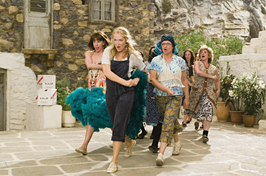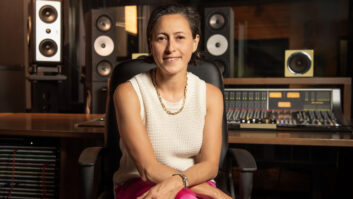
Photo: Peter Mountain © 2008 Universal Studios. All Rights Reserved
Even though 1970s pop titans ABBA have sold more than 250 million records worldwide, they were never huge in the U.S. (just four Top 10 hits), and it was definitely something of a surprise when the group’s glossy, lightweight sound became the basis of a very successful Broadway musical, Mamma Mia!, nearly seven years ago. Less surprising is that the crowd-pleasing spectacle — still playing on Broadway and in touring companies — has now found its way to the big screen: Mamma Mia! is the first feature film directed by Phyllida Lloyd, heretofore known primarily for her opera and theater work in England. It was shot at Shepperton Studios in London and on location in the Greek islands where the slight but cute story takes place. Meryl Streep is the unexpected “name” above the title who can really sing (though you already knew that if you saw A Prairie Home Companion), while Pierce Brosnan and Colin Firth are the eye-candy for the film’s target audience of middle-aged female ABBA fans.
The sound production crew was nearly entirely English, the music was produced mainly in Sweden (where ABBA members and film co-producers Benny Andersson and Bjorn Ulvaeus still live), but the final mix, at Sound One in New York, was headed by a pair of Americans: Dominick Tavella and Michael Barry. Tavella earned an Oscar for his effects mixing work on Chicago in 2003, and has a long, distinguished career working on many of the top films to come out of New York, including numerous music-oriented productions. Music and dialog mixer Barry has likewise worked with many of the best independent filmmakers (Woody Allen, the Coen Brothers, Robert Altman) and also on such major commercial releases as Michael Clayton, Music and Lyrics and The Stepford Wives.
“You would never know from looking at Mamma Mia! that Phyllida wasn’t an experienced film director,” Tavella notes during a break from the final mix in Sound One’s Neve DFC-equipped Studio A in the historic Brill Building on Broadway in midtown Manhattan. “She did a marvelous job. It opens up really nicely and it moves very well, which you want in a musical.”
“I can’t compliment everyone who worked on this film enough,” adds Barry. “It feels very cinematic to me rather than theatrical, although there are elements of each. It’s faithful to the [stage] musical; at the same time, it uses the film medium really well.”
From Tavella’s standpoint, the most challenging aspect of FX mixing on a musical “is that the music is integrated into the rest of the film smoothly. You don’t want to feel like the film is stopping, the music is starting, then it stops again and then you’re back in the film. The beginning and the end [of the songs] have to integrate with the dialog; it’s got to flow. Once you’re past the transition, you can do whatever you want, but getting into the song has to feel as seamless as you can possibly get.”
Asked if there were similarities between working on Mamma Mia! and Chicago in that regard, Tavella replies, “They’re different beasts in that the way the music in Chicago worked in the film was that people sort of went into dream states, and on just about every music piece in Chicago there was like a 25- or 30-second flow from reality into the dream state. This was very different. This was more like a traditional musical in that people will talk and then they’ll start singing. The musical pieces are very well-integrated into the story, but they’re part of the story, so you want it to feel more like reality.”
Most of the music and singing was prerecorded in a studio and then lip-synched during production, but Barry says that in some instances, the actors sang live to playback. “Obviously, when Meryl Streep is singing on a cliff in Greece, that’s probably not going to be live, but it’s all done well enough that it’s not so obvious.”
Although the music is always kept out-front as much as possible, for reality’s sake care was taken to keep FX playing during the musical numbers. “You can’t be too aggressive with it because you don’t want Foley popping out,” Tavella says, “but you don’t want it to disappear, so it becomes only music. It’s actually quite nice because in the quiet parts of the music, you can feel the wind or the crickets or some movement.”
Barry had extensive Pro Tools music stems with which to work in the final mix, though not many liberties were taken with these new versions of the original arrangements, which the ABBA members wanted to preserve in the film. “The majority of the music is played for fun and energy and excitement and the sheer joy of just listening to the music,” he says. “This film was so much fun to work on. The music helped put everyone’s spirits up constantly. To go to work every day and be in that environment was very exciting.”



